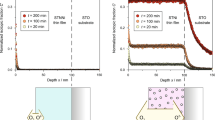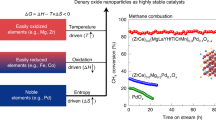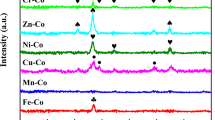Abstract
Heat involved in catalytic reactions can influence the local temperature and performance of the active site, potentially causing catalyst degradation and runaway scenarios. Yet, broadly applicable thermometry methods to selectively probe the temperature of the catalytically active phase—where reactions take place—are generally lacking. Here we explore extended X-ray absorption fine-structure thermometry to monitor the operando temperature of active Ni nanoparticles, fully deconvoluted from their metal-oxide support. During dry reforming of methane, the reaction’s endothermicity causes Ni nanoparticles to become local heat sinks with their temperature deviating 90 °C from the reactor temperature. By thermometry at the single nanoparticle level, we chart the energy balance of nanoparticles and relate their temperature to reaction kinetics. Covering the full temperature range relevant to catalysis, this broadly applicable method enables temperature monitoring of individual catalyst components separately. Applying extended X-ray absorption fine-structure thermometry to existing datasets worldwide can generate enhanced understanding on reaction-induced temperature phenomena in heterogeneous catalysis.

This is a preview of subscription content, access via your institution
Access options
Access Nature and 54 other Nature Portfolio journals
Get Nature+, our best-value online-access subscription
$32.99 / 30 days
cancel any time
Subscribe to this journal
Receive 12 digital issues and online access to articles
$119.00 per year
only $9.92 per issue
Buy this article
- Purchase on SpringerLink
- Instant access to full article PDF
Prices may be subject to local taxes which are calculated during checkout




Similar content being viewed by others
Data availability
All data are available from the corresponding authors upon reasonable request.
Code availability
Code to perform EXAFS thermometry is available via GitHub at https://github.com/matthiasfilez/EXAFS-thermometry.
References
Dumesic, J. A., Huber, G. W. & Boudart, M. Handbook of Heterogeneous Catalysis (Wiley, 2008).
Somorjai, G. A. & Li, Y. Introduction to Surface Chemistry and Catalysis (Wiley, 2010).
Nørskov, J. K. et al. The nature of the active site in heterogeneous metal catalysis. Chem. Soc. Rev. 37, 2163–2171 (2008).
Marin, G. B. & Yablonsky, G. Kinetics of Chemical Reactions: Decoding Complexity (Wiley, 2011).
Liu, L. & Corma, A. Metal catalysts for heterogeneous catalysis: from single atoms to nanoclusters and nanoparticles. Chem. Rev. 118, 4981–5079 (2018).
Bañares, M. A. Operando spectroscopy: the knowledge bridge to assessing structure–performance relationships in catalyst nanoparticles. Adv. Mater. 23, 5293–5301 (2011).
Groppo, E., Rojas-Buzo, S. & Bordiga, S. The role of in situ/operando IR spectroscopy in unraveling adsorbate-induced structural changes in heterogeneous catalysis. Chem. Rev. 123, 12135–12169 (2023).
Buurmans, I. L. C. & Weckhuysen, B. M. Heterogeneities of individual catalyst particles in space and time as monitored by spectroscopy. Nat. Chem. 4, 873–886 (2012).
Singh, J., Lamberti, C. & van Bokhoven, J. A. Advanced X-ray absorption and emission spectroscopy: in situ catalytic studies. Chem. Soc. Rev. 39, 4754–4766 (2010).
Meirer, F. & Weckhuysen, B. M. Spatial and temporal exploration of heterogeneous catalysts with synchrotron radiation. Nat. Rev. Mater. 3, 324–340 (2018).
Werghi, B. et al. Selective catalytic behavior induced by crystal-phase transformation in well-defined bimetallic Pt–Sn nanocrystals. Small 19, 2207956 (2023).
Filez, M. et al. Formation and functioning of bimetallic nanocatalysts: the power of X-ray probes. Angew. Chem. Int. Ed. 58, 13220–13230 (2019).
Roldan Cuenya, B. Metal nanoparticle catalysts beginning to shape-up. Acc. Chem. Res. 46, 1682–1691 (2013).
Sarma, B. B., Maurer, F., Doronkin, D. E. & Grunwaldt, J.-D. Design of single-atom catalysts and tracking their fate using operando and advanced X-ray spectroscopic tools. Chem. Rev. 123, 379–444 (2023).
Timoshenko, J. & Roldan Cuenya, B. In situ/operando electrocatalyst characterization by X-ray absorption spectroscopy. Chem. Rev. 121, 882–961 (2021).
Urakawa, A. & Baiker, A. Space-resolved profiling relevant in heterogeneous catalysis. Top. Catal. 52, 1312–1322 (2009).
Mitchell, S., Qin, R., Zheng, N. & Pérez-Ramírez, J. Nanoscale engineering of catalytic materials for sustainable technologies. Nat. Nanotechnol. 16, 129–139 (2021).
Marberger, A. et al. Time-resolved copper speciation during selective catalytic reduction of NO on Cu-SSZ-13. Nat. Catal. 1, 221–227 (2018).
Potter, M. E. et al. A high pressure operando spectroscopy examination of bimetal interactions in ‘metal efficient’ palladium/In2O3/Al2O3 catalysts for CO2 hydrogenation. Angew. Chem. Int. Ed. 62, e202312645 (2023).
Qi, G. et al. Au-ZSM-5 catalyses the selective oxidation of CH4 to CH3OH and CH3COOH using O2. Nat. Catal. 5, 45–54 (2022).
Wei, J. On the maximum temperature inside a porous catalyst. Chem. Eng. Sci. 21, 1171–1183 (1966).
Grunwaldt, J.-D., Wagner, J. B. & Dunin-Borkowski, R. E. Imaging catalysts at work: a hierarchical approach from the macro- to the meso- and nano-scale. ChemCatChem 5, 62–80 (2013).
Tiburski, C., Nugroho, F. A. A. & Langhammer, C. Optical hydrogen nanothermometry of plasmonic nanoparticles under illumination. ACS Nano 16, 6233–6243 (2022).
Georgiades, G., Self, V. A. & Sermon, P. A. IR emission analysis of temperature profiles in Pt/SiO2 catalysts during exothermic reactions. Angew. Chem. Int. Ed. 26, 1042–1043 (1987).
Simeone, M., Salemme, L. & Allouis, C. Reactor temperature profile during autothermal methane reforming on Rh/Al2O3 catalyst by IR imaging. Int. J. Hydrogen Energy 33, 4798–4808 (2008).
Hannemann, S. et al. Axial changes of catalyst structure and temperature in a fixed-bed microreactor during noble metal catalysed partial oxidation of methane. Top. Catal. 52, 1360–1370 (2009).
Geitenbeek, R. G. et al. In situ luminescence thermometry to locally measure temperature gradients during catalytic reactions. ACS Catal. 8, 2397–2401 (2018).
Hartman, T., Geitenbeek, R. G., Whiting, G. T. & Weckhuysen, B. M. Operando monitoring of temperature and active species at the single catalyst particle level. Nat. Catal. 2, 986–996 (2019).
Hartman, T., Geitenbeek, R. G., Wondergem, C. S., van der Stam, W. & Weckhuysen, B. M. Operando nanoscale sensors in catalysis: all eyes on catalyst particles. ACS Nano 14, 3725–3735 (2020).
Terlingen, B. J. P. et al. Bifunctional europium for operando catalyst thermometry in an exothermic chemical reaction. Angew. Chem. Int. Ed. 61, e202211991 (2022).
Jacobs, T. S. et al. Mapping temperature heterogeneities during catalytic CO2 methanation with operando luminescence thermometry. ACS Nano 17, 20053–20061 (2023).
Munnik, P., de Jongh, P. E. & de Jong, K. P. Recent developments in the synthesis of supported catalysts. Chem. Rev. 115, 6687–6718 (2015).
Koptyug, I. V., Khomichev, A. V., Lysova, A. A. & Sagdeev, R. Z. Spatially resolved NMR thermometry of an operating fixed-bed catalytic reactor. J. Am. Chem. Soc. 130, 10452–10453 (2008).
Cale, T. S. Nickel crystallite thermometry during ethane hydrogenolysis. J. Catal. 90, 40–48 (1984).
Van de Broek, B. et al. Temperature determination of resonantly excited plasmonic branched gold nanoparticles by X-ray absorption spectroscopy. Small 7, 2498–2506 (2011).
Rosen, D. J., Yang, S., Marino, E., Jiang, Z. & Murray, C. B. In situ EXAFS-based nanothermometry of heterodimer nanocrystals under induction heating. J. Phys. Chem. C 126, 3623–3634 (2022).
Espinosa, A. et al. Photoactivated nanoscale temperature gradient detection using X-ray absorption spectroscopy as a direct nanothermometry method. Nano Lett. 21, 769–777 (2021).
Ano, T. et al. Probing the temperature of supported platinum nanoparticles under microwave irradiation by in situ and operando XAFS. Commun. Chem. 3, 86 (2020).
López-Méndez, R. et al. X-ray nanothermometry of nanoparticles in tumor-mimicking tissues under photothermia. Adv. Healthc. Mater. 12, 2301863 (2023).
La Fontaine, C., Belin, S., Barthe, L., Roudenko, O. & Briois, V. ROCK: a beamline tailored for catalysis and energy-related materials from ms time resolution to μm spatial resolution. Synchrotron Radiat. News 33, 20–25 (2020).
Koningsberger, D. C., Mojet, B. L., Van Dorssen, G. E. & Ramaker, D. E. XAFS spectroscopy; fundamental principles and data analysis. Top. Catal. 10, 143–155 (2000).
Rehr, J. J. Theoretical approaches to X-ray absorption fine structure. Rev. Mod. Phys. 72, 621–654 (2000).
Pinto, D., Hu, L. & Urakawa, A. Enabling complete conversion of CH4 and CO2 in dynamic coke-mediated dry reforming (DC-DRM) on Ni catalysts. Chem. Eng. J. 474, 145641 (2023).
Martín, A. J., Mitchell, S., Mondelli, C., Jaydev, S. & Pérez-Ramírez, J. Unifying views on catalyst deactivation. Nat. Catal. 5, 854–866 (2022).
Filez, M. et al. Nanoscale chemical diversity of coke deposits on nanoprinted metal catalysts visualized by tip-enhanced Raman spectroscopy. Adv. Mater. 36, 2305984 (2024).
Duan, M. et al. Reconstruction of supported metal nanoparticles in reaction conditions. Angew. Chem. Int. Ed. 57, 6464–6469 (2018).
Chmielewski, A. et al. Reshaping dynamics of gold nanoparticles under H2 and O2 at atmospheric pressure. ACS Nano 13, 2024–2033 (2019).
Solano, E. et al. Metal nanocatalyst sintering interrogated at complementary length scales. Small 19, 2205217 (2023).
Dai, Y., Lu, P., Cao, Z., Campbell, C. T. & Xia, Y. The physical chemistry and materials science behind sinter-resistant catalysts. Chem. Soc. Rev. 47, 4314–4331 (2018).
Vogt, C. & Weckhuysen, B. M. The concept of active site in heterogeneous catalysis. Nat. Rev. Chem. 6, 89–111 (2022).
Tian, Y. et al. Spatiotemporal heterogeneity of temperature and catalytic activation within individual catalyst particles. J. Am. Chem. Soc. 146, 4958–4972 (2024).
Taniike, T. & Takahashi, K. The value of negative results in data-driven catalysis research. Nat. Catal. 6, 108–111 (2023).
Theofanidis, S. A., Galvita, V. V., Poelman, H. & Marin, G. B. Enhanced carbon-resistant dry reforming Fe–Ni catalyst: role of Fe. ACS Catal. 5, 3028–3039 (2015).
De Coster, V., Srinath, N. V., Yazdani, P., Poelman, H. & Galvita, V. V. Does CO2 oxidize Ni catalysts? A quick X-ray absorption spectroscopy answer. J. Phys. Chem. Lett. 13, 7947–7952 (2022).
Briois, V. et al. ROCK: the new Quick-EXAFS beamline at SOLEIL. J. Phys. Conf. Ser. 712, 012149 (2016).
Stötzel, J., Lützenkirchen-Hecht, D. & Frahm, R. A new flexible monochromator setup for quick scanning X-ray absorption spectroscopy. Rev. Sci. Instrum. 81, 073109 (2010).
Lesage, C. et al. High pressure cell for edge jumping X-ray absorption spectroscopy: applications to industrial liquid sulfidation of hydrotreatment catalysts. Catal. Today 336, 63–73 (2019).
Acknowledgements
M.F. acknowledges the FWO for a senior postdoctoral research fellowship (1280621N). This work was supported by the Fund for Scientific Research Flanders (grant no. G0A5923N (M.B.J.R. and C.D.), 3G021220 (V.G. and C.D.), G093823N (M.F. and J.D.)) and the Special Research Fund BOF of Ghent University (grant no. GOA-01G02124 (M.F., J.D. and C.D.)). The research leading to these results is supported by the project CALIPSOplus under grant agreement 730872 from the EU Framework Programme for Research and Innovation HORIZON 2020, in supplying financing of subsistence costs for the synchrotron campaign (SOLEIL, proposal 20200555 (V.D.C., H.P. and V.G.). We acknowledge the assistance from the ROCK staff for a smooth beamtime.
Author information
Authors and Affiliations
Contributions
M.F., J.D., M.B.J.R. and C.D. conceived the research idea and project. V.D.C., H.P. and V.G. produced the samples and collected the XAS data together with V.B. and A.B. M.F., V.D.C. and A.B. preprocessed the data. M.F. developed the thermometry workflow and data analysis with the support of V.D.C. M.F. and V.G. collected the transmission electron microscopy data. M.F. analysed the transmission electron microscopy data and wrote the paper. All authors contributed to revising and optimizing the paper.
Corresponding authors
Ethics declarations
Competing interests
The authors declare no competing interests.
Peer review
Peer review information
Nature Catalysis thanks Ken Motokura and the other, anonymous, reviewer(s) for their contribution to the peer review of this work.
Additional information
Publisher’s note Springer Nature remains neutral with regard to jurisdictional claims in published maps and institutional affiliations.
Supplementary information
Supplementary Information
Supplementary Figs. 1–11, Tables 1–4 and Notes 1–8.
Rights and permissions
Springer Nature or its licensor (e.g. a society or other partner) holds exclusive rights to this article under a publishing agreement with the author(s) or other rightsholder(s); author self-archiving of the accepted manuscript version of this article is solely governed by the terms of such publishing agreement and applicable law.
About this article
Cite this article
Filez, M., De Coster, V., Poelman, H. et al. Selectively monitoring the operando temperature of active metal nanoparticles during catalytic reactions by X-ray absorption nanothermometry. Nat Catal 8, 187–195 (2025). https://doi.org/10.1038/s41929-025-01295-9
Received:
Accepted:
Published:
Issue date:
DOI: https://doi.org/10.1038/s41929-025-01295-9



